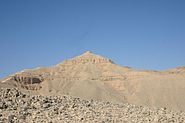- Medinet Habu (temple)
-
Coordinates: 25°43′10.92″N 32°36′2.52″E / 25.7197°N 32.6007°E
This article is about the temple. For other uses, see Medinet Habu (disambiguation).Medinet Habu is the name commonly given to the Mortuary Temple of Ramesses III, an important New Kingdom period structure in the location of the same name on the West Bank of Luxor in Egypt. Aside from its intrinsic size and architectural and artistic importance, the temple is probably best known as the source of inscribed reliefs depicting the advent and defeat of the Sea Peoples during the reign of Ramesses III.
Contents
Description
The temple, some 150 m long, is of orthodox design, and resembles closely the nearby mortuary temple of Ramesses II (the Ramesseum). The temple precinct measures approximately 700 ft (210 m). by 1,000 ft (300 m) and contains more than 75,350 sq ft (7,000 m2) of decorated wall reliefs.[1] Its walls are relatively well preserved and it is surrounded by a massive mudbrick enclosure, which may have been fortified. The original entrance is through a fortified gate-house, known as a migdol (a common architectural feature of Asiatic fortresses of the time).
Just inside the enclosure, to the south, are chapels of Amenirdis I, Shepenupet II and Nitiqret, all of whom had the title of Divine Adoratrice of Amun.
The first pylon leads into an open courtyard, lined with colossal statues of Ramesses III as Osiris on one side, and uncarved columns on the other. The second pylon leads into a peristyle hall, again featuring columns in the shape of Ramesses. This leads up a ramp that leads (through a columned portico) to the third pylon and then into the large hypostyle hall (which has lost its roof). Reliefs and actual heads of foreign captives were also found placed within the temple perhaps in an attempt to symbolise the king's control over Syria and Nubia.
In Coptic times, there was a church inside the temple structure, which has since been removed. Some of the carvings in the main wall of the temple have been altered by coptic carvings.
Excavation
Initial excavation of the temple took place sporadically between 1859 and 1899, under the auspices of the Egyptian Antiquities Service. During these decades the main temple was cleared, a large number of Coptic period buildings removed and the site made accessible to visitors.
The further excavation, recording and conservation of the temple has been facilitated in chief part by the Architectural and Epigraphic Surveys of University of Chicago's Oriental Institute, almost continuously since 1924.
Further reading and references
- ^ Medinet Habu by M. Parsons
- William J. Murnane, United with Eternity – A Concise Guide to the Monuments of Medinet Habu, Oriental Institute, University of Chicago and the American University of Cairo Press, 1980. ISBN 0-918986-28-1
Archaeological reports
- The Epigraphic Survey, Medinet Habu I, Earlier Historical Records of Ramses III (OIP 8; Chicago, 1930)
- The Epigraphic Survey, Medinet Habu II, Later Historical Records of Ramses III (OIP 9; Chicago, 1932)
- The Epigraphic Survey, Medinet Habu III, The Calendar, the 'Slaughter House,' and Minor Records of Ramses III (OIP 23; Chicago, 1934)
- The Epigraphic Survey, Medinet Habu IV, Festival Scenes of Ramses III (OIP 51; Chicago, 1940)
- The Epigraphic Survey, Medinet Habu V, The Temple Proper, part 1 (OIP 83; Chicago, 1957)
- The Epigraphic Survey, Medinet Habu VI, The Temple Proper, part 2 (OIP 84; Chicago, 1963)
- The Epigraphic Survey, Medinet Habu VII, The Temple Proper, part 3 (OIP 93; Chicago, 1964)
- The Epigraphic Survey, Medinet Habu VIII, The Eastern High Gate (OIP 94; Chicago, 1970)
- W. F. Edgerton, Medinet Habu Graffiti Facsimiles (OIP 36; Chicago, 1937)
- Uvo Hölscher, Medinet Habu 1924-1928. II The Architectural Survey of the Great Temple and Palace of Medinet Habu (season 1927-28). OIC, No. 5. Chicago: University of Chicago Press, 1929.
- H. J. Thissen, Die demotischen Graffiti von Medinet Habu: Zeugnisse zu Tempel und Kult im Ptolemäischen Ägypten (Demotische Studien 10; Sommerhausen, 1989)
See also
External links
- The Epigraphic Survey – The Oriental Institute, University of Chicago
- A Foreign Captive at Medinet Habu
- Medinet Habu Picture Gallery 2006
- "The Age of Iron". Richard Miles. Ancient Worlds. BBC 2. 9:20 minutes in. Retrieved on 20 Nov 201.
Theban Necropolis Temple sites Deir el-Bahri · Medinet Habu · Mortuary Temple of Seti I · Mortuary Temple of Amenhotep III · Ramesseum
Royal Necropolis Other Burials Other Categories:- 12th-century BC architecture
- Theban Necropolis
- Colossal statues
Wikimedia Foundation. 2010.







